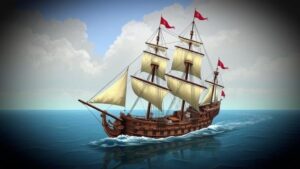Locating Lost Ships Using Historical Navigation Charts and Records
Locating Lost Ships Using Historical Navigation Charts and Records
The quest to locate lost ships, whether for archaeological research, salvaging treasures, or historical documentation, has evolved significantly over the centuries. With advancements in technology, historians, archaeologists, and marine scientists are leveraging historical navigation charts and records to pinpoint the resting places of vessels that have long been forgotten beneath the waves. This article explores the methodologies involved, real-world applications, and the intriguing case studies that highlight how these ancient documents are invaluable in maritime exploration.
The Importance of Historical Navigation Charts
Historical navigation charts are essential tools that provide insights into maritime routes, environmental conditions, and ship movements over time. Prior to the advent of modern GPS and navigational technologies, sailors relied heavily on these charts for safe passage. The information contained within these documents can be categorized into several key areas:
- Geographical Features: Charts often include topographical details such as coastlines, harbors, and underwater features.
- Weather Patterns: Historical records can indicate prevalent weather conditions, tides, and currents during specific timeframes.
- Nautical Data: Many charts detail navigational aids, such as lighthouses and buoys, which are valuable for re-tracing lost routes.
For example, the British Admiralty charts from the 18th and 19th centuries contain meticulous records that map not only sea routes but also shipwreck sites, making them a vital resource for contemporary researchers.
Historical Records: A Treasure Trove of Information
Beyond navigation charts, various historical records contribute significantly to understanding maritime history, including:
- Logbooks: Ship logbooks provide real-time accounts of voyages, including weather conditions, locations, and reasons for course changes.
- Newspapers and Journals: Reports from the time of shipwrecks or loss can shed light on the circumstances surrounding the incidents.
- Shipping Registers: These documents give insights into the ships specifications, ownership, and cargo, aiding in reconstructing lost ship histories.
In the case of the infamous shipwreck of the SS Central America in 1857, researchers utilized newspapers and logbooks to piece together the events leading to its sinking, leading to the eventual discovery of its wreckage and significant treasure off the coast of South Carolina.
Integrating Technology with Historical Data
The advent of advanced technology has revolutionized how researchers locate lost ships. Techniques such as Geographic Information Systems (GIS), sonar mapping, and underwater drones complement historical data in identifying shipwreck sites. GIS, for example, allows scientists to layer various types of information, including historical charts and modern data, which helps visualize potential locations of lost vessels.
Also, Remote Operated Vehicles (ROVs) equipped with sonar technology have become indispensable. These vehicles can scan vast areas of the ocean floor with high precision and can operate in depths inaccessible to human divers. For example, the discovery of the USS Indianapolis wreck in 2017 employed sonar technology to validate historical records that indicated its last known positions.
Case Studies of Successful Ship Recoveries
Numerous successful recoveries of lost ships illustrate the effectiveness of combining historical navigation charts and modern technology:
- Admiral George Deweys USS Olympia: After being lost for decades, historical maps and underwater surveys led to the discovery of the USS Olympia off the coast of Pennsylvania, revealing valuable artifacts and insights into U.S. naval history.
- The Endurance Expedition: The famous ship of explorer Ernest Shackleton was located in 2022. Researchers turned to historical charts summarizing the Antarctic conditions during the early 20th century, coupled with modern scanning techniques.
These case studies demonstrate not only the success of these methodologies but also the rich historical and cultural narratives that accompany them.
Challenges and Limitations
Despite the benefits, challenges persist in utilizing historical navigation charts and records. Issues such as:
- Data Gaps: Inconsistencies or missing information in historical documents can hinder accurate location efforts.
- Environmental Changes: Coastal erosion, shifting seabeds, and human activity can alter the landscape, making it difficult to match old data with current conditions.
Also, ethical considerations arise regarding the salvaging of shipwrecks, particularly in cases involving human remains or culturally sensitive artifacts, necessitating a delicate balance between exploration and respect for history.
Conclusion and Actionable Takeaways
The endeavor of locating lost ships through historical navigation charts and records exemplifies a unique convergence of history, technology, and exploration. It offers profound insights not only into maritime routes of the past but also into human resilience and adaptability in the face of the unknown.
For enthusiasts and researchers looking to engage in this field:
- Begin by compiling historical records and nautical charts for local shipwreck sites.
- Leverage modern technology, such as GIS and sonar, for effective data analysis and visualization.
- Collaborate with maritime historians and archaeologists for a comprehensive approach to ship discovery.
Through interdisciplinary efforts, future discoveries promise to continue enriching our understanding of maritime history while honoring the stories of those who traversed the seas.



